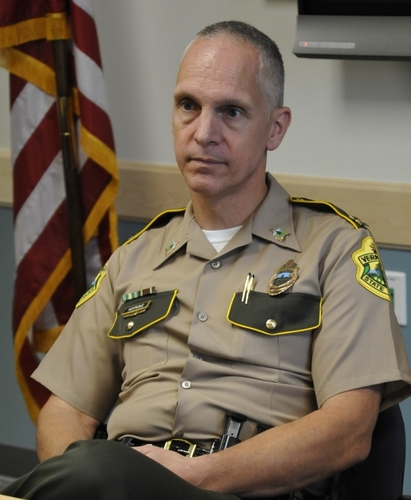BRATTLEBORO — At first glance, the newly consolidated Vermont State Police troop areas look daunting.
The new incarnation of Troop B stretches from Brattleboro and Bennington to Randolph and Vergennes. And the reconfigured Troop A includes all of northern Vermont, from barracks in Williston and St. Albans to stations in St. Johnsbury and Derby.
That means fewer captains are overseeing bigger portions of the state. But state police administrators say the change is a way to free up management manpower for new initiatives while not weakening law enforcement activities.
“We thought it was just a smarter way to do business,” said state police Major Rick Hopkins.
Added state police spokesman Scott Waterman: “We haven't reduced the number of troopers. We haven't reduced our services.”
Consolidation and reorganization have been themes in recent years for the state police. Officials in 2015 consolidated four emergency call centers into two, now housed at the Williston and Westminster barracks.
And the overall number of state police barracks has decreased from 12 to 10. Bradford's barracks has become an “outpost” of the St. Johnsbury barracks, and last year the Brattleboro and Rockingham barracks were closed and combined into a new, expanded station off Interstate 91 in Westminster.
Those changes provide context for the troop realignment, which officially took effect Jan. 1.
Revised structure
Previously, there had been four state police troops. In the north, Troop A had encompassed the St. Albans, Williston, and Middlesex barracks, while Troop B consisted of the Derby and St. Johnsbury barracks.
Troop C encompassed the New Haven, Rutland, and Shaftsbury barracks, while Troop D featured the Royalton and Westminster stations.
The revised structure, as outlined in a map on the state police website, folds all of the former Troop A and B barracks into one new troop in northern Vermont. Similarly, the former Troop C and D barracks have been combined into a sprawling southern/central Vermont troop.
Waterman characterized it as “essentially an administrative streamlining and a command structure simplification.”
At one point, each of the four former troops was overseen by a state police captain. So the new structure frees up two captains for other work, Waterman said.
Though the new troop alignment formally was enacted this month, the supervisory shift actually has taken place incrementally over the past year or so, Hopkins said. The two southern troops had been overseen by one captain since late 2015, and the two northern troops followed suit last year.
Officials said the change has helped make state police captains available for new initiatives like a Major Crimes Unit and a director of “Fair and Impartial Policing and Community Affairs.”
That latter post, announced in 2016, is aimed at building better relationships with minorities, diversifying the state police ranks, and “improving cultural awareness.”
Streamlining operations
Hopkins said the goal is to find command efficiencies while also implementing the new policies of Col. Matthew Birmingham, who took over as state police director in 2015.
“We're trying to be as smart with our limited resources as we can be, and be responsive to the problems of the day,” Hopkins said.
He acknowledged that, at the troop level, there are now two captains - Capt. Robert Cushing in the north and Capt. Michael Manley in the south - who are covering far more territory than they used to.
But Hopkins said the job is “doable.” He's drawing on his own experience for that assessment: Hopkins had been serving as a supervisor for the former C and D troops.
For one thing, he said, modern communications technology makes it much easier to oversee such a large area. State police are looking to improve those lines of communication, including ways to make sharing large video files easier.
“We're looking at software now that will help with that,” Hopkins said.
Also, Hopkins said it isn't necessary for troop captains to be physically present to do their jobs.
“They're managers. So they don't need to be on the ground,” Hopkins said. “Every one of those stations has a lieutenant ... they're the operational person who runs the show.”
He added that, at the ground level, state police have sought to bolster management by adding a sergeant position at each barracks. “We've actually increased oversight in the past year,” Hopkins said.
